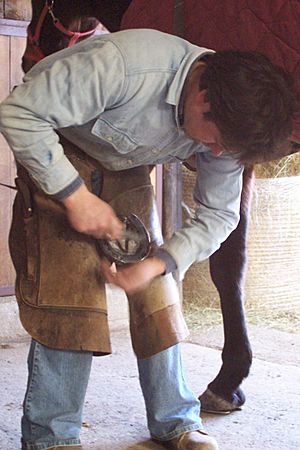Horseshoe facts for kids
Horseshoes are special protective covers for a horse's feet. Think of them like shoes for horses! They help keep a horse's hooves safe when they walk on hard or rough ground.
A person called a farrier makes and attaches horseshoes. They can nail or glue them onto the horse's hoof (which is like a very strong fingernail). Horseshoes are usually made from materials like iron, rubber, plastic, or a mix of these.
Horseshoes are also used in other ways! Long ago, many people believed that hanging a horseshoe over a doorway brought good luck. They thought it would protect anyone walking under it from bad spirits. Horseshoes are also part of a fun game where players try to throw them onto a pole.
Contents
How Horses Get Their Shoes
Getting new shoes doesn't hurt a horse at all! A farrier is like a special hoof doctor. They carefully trim the part of the hoof that has no feeling, just like you trim your fingernails. This is the same area where they gently put the nails.
Preparing the Hoof
Before putting on new shoes, the farrier takes off the old ones. They use special tools like pincers, which are like big pliers. Then, they trim the hoof wall to the right length. They also clean and shape the sole and the frog (a V-shaped part) of the hoof with a hoof knife.
Horses' hooves grow constantly, just like our nails. In the wild, their hooves would naturally wear down. But with shoes, they don't wear down as much. If the hoof gets too long, it can cause problems for the horse's legs. The bones inside the hoof need to line up perfectly with the bones in the pastern (the part of the leg above the hoof). Trimming keeps everything straight and healthy.
Shaping the Horseshoe
After trimming, the farrier measures the horse's foot. They then bend the horseshoe to fit perfectly. They use a hammer and an anvil (a heavy metal block) to shape the metal. Sometimes, they add special parts like taps for shoe studs.
Farriers can shape shoes in two ways:
- Cold shoeing: The farrier bends the metal shoe without heating it.
- Hot shoeing: The farrier heats the metal in a special oven called a forge before bending it.
Hot shoeing takes more time and needs a forge. However, it often gives a better fit. When a hot shoe touches the hoof, it leaves a slight mark. This mark shows the farrier exactly how well the shoe fits. Hot shoeing also lets the farrier make more changes to the shoe. The farrier must be careful not to hold the hot shoe on the hoof for too long, so it doesn't harm the hoof.
Attaching the Shoe
Once the hot shoe is shaped, the farrier cools it in water. Then, they nail the shoes onto the hoof wall. They drive the nails into the "white line" of the hoof. The nails are shaped so they curve outwards as they go in. This way, they avoid the sensitive inner part of the horse's foot. The nails come out on the sides of the hoof.
When a nail is fully in, the farrier cuts off the sharp points. They then use a special tool called a clincher to bend the rest of the nail. This makes the nail almost flat against the hoof wall. This stops the nail from catching on anything. It also helps hold the shoe firmly in place.
Finally, the farrier uses a rasp, which is a large file. They smooth the edge where the hoof meets the shoe. This removes any sharp edges left from cutting the nails.
Images for kids
-
A variety of horseshoes, including aluminum racing plates (light or dark); there is also a variety of oxshoes at the lower right
See also
 In Spanish: Herradura para niños
In Spanish: Herradura para niños












